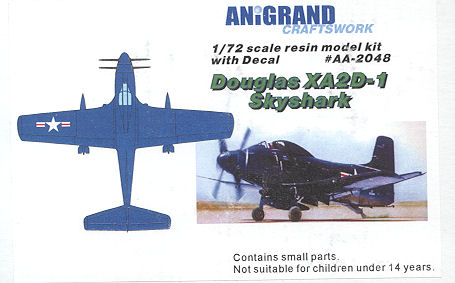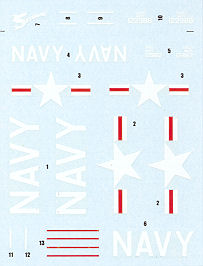
| KIT: | Anigrand Craftworks 1/72 A2D-1 Skyshark |
| KIT #: | AA-2048 |
| PRICE: | $49.00 from Nostalgic Plastic (free US shipping) |
| DECALS: | One option |
| REVIEWER: | Scott Van Aken |
| NOTES: | Resin short run kit with vac canopy |

| HISTORY |
In June 1945, with the success of the high performance AD Skyraider, the US Navy asked Douglas to design a new version of the AD with turbo-prop power, and selected Allison to design the power-plant. Allison proposed to install a pair of nose mounted engines to drive two contra-rotating propellers. In cruise flight, one of the engines and propellers could be shut down to increase the flight range. In 1947, two prototypes - designated XA2D-1 Skyshark - were ordered. The first flight was made in 1950. Performance was satisfactory but an engine vibration problem appeared. With the outbreak of the Korean War, the US Navy needed a new carrier based attack aircraft; the A2D-1 was ordered into production. However, the engine problem persisted and the first prototype crashed. The flight tests continued until one of the pre-production aircraft crashed in 1954. After that incident, the A2D-1 never flew again.
| THE KIT |
 Molded
in Anigrand's usual buff resin, the molding on this is on par with previous
kits, with somewhat large engraved panel lines, but really nicely done bits and
pieces. What first grabbed my attention were the complete wing drop tanks with
the fins molded in place. Thanks to no mold glitches, these look superb and I do
hope they are a sign of things to come. Along with the centerline tank, the
pylons are molded in place. If you choose not to use them, that is fine as the
Skyshark did not always fly with these.
Molded
in Anigrand's usual buff resin, the molding on this is on par with previous
kits, with somewhat large engraved panel lines, but really nicely done bits and
pieces. What first grabbed my attention were the complete wing drop tanks with
the fins molded in place. Thanks to no mold glitches, these look superb and I do
hope they are a sign of things to come. Along with the centerline tank, the
pylons are molded in place. If you choose not to use them, that is fine as the
Skyshark did not always fly with these.
There is a three piece cockpit with a seat, control
stick and instrument panel. The seat is nicely done with molded in harness,
while the instrument panel is just a flat piece and the control stick looks a
bit odd. The prop blades all have recesses in the spinners into which they fit.
The instructions say nothing about which way the blades go, so carefully check
references as they do spin in
opposite directions. I also found some large resin blobs on the back or inside
of the spinners that will have to be removed. Fortunately, none of the prop
holes are encumbered. No air bubbles anywhere on the blades, which is great.
Care will need to be taken when sanding off the pour stubs to prevent chipping
the tips, however.
they do spin in
opposite directions. I also found some large resin blobs on the back or inside
of the spinners that will have to be removed. Fortunately, none of the prop
holes are encumbered. No air bubbles anywhere on the blades, which is great.
Care will need to be taken when sanding off the pour stubs to prevent chipping
the tips, however.
The rest of the it is pretty standard for the genre. I did notice a bit of a warp in one wing, but hot water/air will take that out without any problem. A single vac canopy is provided and whether this is a sign of thing to come or not, there are actually easy to see frame lines on this one, making masking a lot easier.
The instructions are par for the course with a single sheet. One one side is a short history, photo of an aircraft and exploded view/parts list. The other side is a decal and painting diagram. Decals are nicely done and are for one of the overall sea blue prototypes. If you want to do an unpainted metal production aircraft, you will have to dig up markings elsewhere. The markings should be quite opaque as my XF-87 build had superbly done white nose markings.
| CONCLUSIONS |
I have to say that Anigrand continues to produce fascinating subjects that the modeler wants to build. This one is no different and is enhanced by what seems to be an improvement in mold quality. Thanks to its simplicity of construction, it is a kit I can recommend for those who are ready for a full resin kit.
January 2006
Thank you to Nostalgic Plastic, the Anigrand USA importer, for the review kit.
If you would like your product reviewed fairly and quickly by a site that has over 300,000 visitors a month, please contact me or see other details in the Note to Contributors.